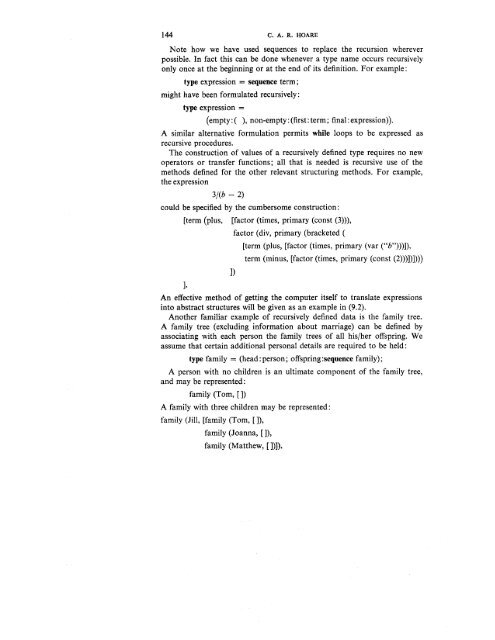II. Notes on Data Structuring * - Cornell University
II. Notes on Data Structuring * - Cornell University
II. Notes on Data Structuring * - Cornell University
Create successful ePaper yourself
Turn your PDF publications into a flip-book with our unique Google optimized e-Paper software.
144 C. A. R. HOARE<br />
Note how we have used sequences to replace the recursi<strong>on</strong> wherever<br />
possible. In fact this can be d<strong>on</strong>e whenever a type name occurs recursively<br />
<strong>on</strong>ly <strong>on</strong>ce at the beginning or at the end of its definiti<strong>on</strong>. For example"<br />
type expressi<strong>on</strong> = sequence term;<br />
might have been formulated recursively:<br />
type expressi<strong>on</strong> =<br />
(empty: (), n<strong>on</strong>-empty: (first: term; final: expressi<strong>on</strong>)).<br />
A similar alternative formulati<strong>on</strong> permits while loops to be expressed as<br />
recursive procedures.<br />
The c<strong>on</strong>structi<strong>on</strong> of values of a recursively defined type requires no new<br />
operators or transfer functi<strong>on</strong>s; all that is needed is recursive use of the<br />
methods defined for the other relevant structuring methods. For example,<br />
the expressi<strong>on</strong><br />
3/(b - 2)<br />
could be specified by the cumbersome c<strong>on</strong>structi<strong>on</strong>"<br />
[term (plus, [factor (times, primary (c<strong>on</strong>st (3))),<br />
])<br />
factor (div, primary (bracketed (<br />
[term (plus, [factor (times, primary (var ("b")))]),<br />
term (minus, [factor (times, primary (c<strong>on</strong>st (2)))])])))<br />
1.<br />
An effective method of getting the computer itself to translate expressi<strong>on</strong>s<br />
into abstract structures will be given as an example in (9.2).<br />
Another familiar example of recursively defined data is the family tree.<br />
A family tree (excluding informati<strong>on</strong> about marriage) can be defined by<br />
associating with each pers<strong>on</strong> the family trees of all his/her offspring. We<br />
assume that certain additi<strong>on</strong>al pers<strong>on</strong>al details are required to be held"<br />
type family = (head:pers<strong>on</strong>; offspring :sequence family);<br />
A pers<strong>on</strong> with no children is an ultimate comp<strong>on</strong>ent of the family tree,<br />
and may be represented:<br />
family (Tom, [])<br />
A family with three children may be represented:<br />
family (Jill, [family (Tom, []),<br />
family (Joanna, []),<br />
family (Matthew, [])]).

















